
Hill of Tarvit
Encyclopedia
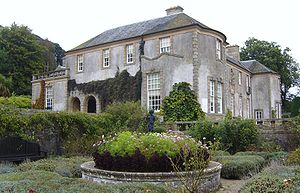
Fife
Fife is a council area and former county of Scotland. It is situated between the Firth of Tay and the Firth of Forth, with inland boundaries to Perth and Kinross and Clackmannanshire...
, Scotland
Scotland
Scotland is a country that is part of the United Kingdom. Occupying the northern third of the island of Great Britain, it shares a border with England to the south and is bounded by the North Sea to the east, the Atlantic Ocean to the north and west, and the North Channel and Irish Sea to the...
. They were designed by Sir Robert Lorimer
Robert Lorimer
Sir Robert Stodart Lorimer was a prolific Scottish architect noted for his restoration work on historic houses and castles, and for promotion of the Arts and Crafts style.-Early life:...
and are today owned by the National Trust for Scotland
National Trust for Scotland
The National Trust for Scotland for Places of Historic Interest or Natural Beauty, commonly known as the National Trust for Scotland describes itself as the conservation charity that protects and promotes Scotland's natural and cultural heritage for present and future generations to...
.
Description
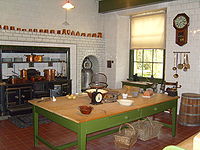
Cupar
Cupar is a town and former royal burgh in Fife, Scotland. The town is situated between Dundee and the New Town of Glenrothes.According to a recent population estimate , Cupar had a population around 8,980 making the town the ninth largest settlement in Fife.-History:The town is believed to have...
, Fife
Fife
Fife is a council area and former county of Scotland. It is situated between the Firth of Tay and the Firth of Forth, with inland boundaries to Perth and Kinross and Clackmannanshire...
. It is set in 40 acres (161,874.4 m²) of garden and 279 acres (1.1 km²) of open estate. This includes woodland, parkland, farmland and open heath, with extensive views.
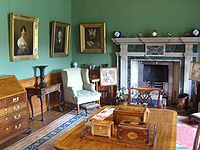
Thomas Chippendale
Thomas Chippendale was a London cabinet-maker and furniture designer in the mid-Georgian, English Rococo, and Neoclassical styles. In 1754 he published a book of his designs, titled The Gentleman and Cabinet Maker's Director...
, porcelain
Porcelain
Porcelain is a ceramic material made by heating raw materials, generally including clay in the form of kaolin, in a kiln to temperatures between and...
and paintings collected by F B Sharp.
The house today and wider estates are owned and operated by the National Trust for Scotland
National Trust for Scotland
The National Trust for Scotland for Places of Historic Interest or Natural Beauty, commonly known as the National Trust for Scotland describes itself as the conservation charity that protects and promotes Scotland's natural and cultural heritage for present and future generations to...
. They display Lorimer's original design and furnishings, and they are open to the public incorporating a tearoom and shop. Visitors are able to see the both the Sharp family's state of the art accommodation, as well as glimpse life "below-stairs" for the servants.
History
The site dates back to at least the Iron AgeIron Age
The Iron Age is the archaeological period generally occurring after the Bronze Age, marked by the prevalent use of iron. The early period of the age is characterized by the widespread use of iron or steel. The adoption of such material coincided with other changes in society, including differing...
. The remains of a homestead were excavated in 1946-7 at the top of Tarvit Hill. During the excavation, an elaborate circular wooden house of about 17 m in diameter was found, it was within an oval bank which enclosed an area of 33x27m. The house is thought to have been occupied between 200 BC and AD 200, and rebuilt at least twice in that period.
Scotstarvit tower
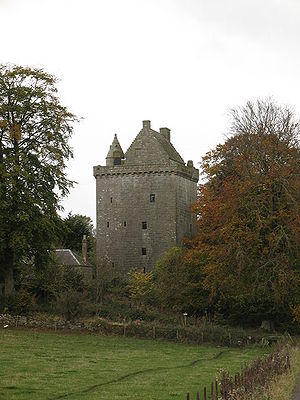
Sir John Scott of Scotstarvit
Sir John Scott of Scotstarvet was a minor Scottish noble, known as a lawyer, statesman and author. He was a Director of Chancery who became a Lord of Session...
. Sir John rebuilt much of the tower in the 1620s - seen by the date 1627 on a piece of the Tower's chimneypiece that now forms part of the fireplace in the Hill of Tarvit's smoking room.
Wemyss Hall
The estate, then known as Unthank was remodelled but John Wemyss of Unthank after 1696. Wemyss, neglected the defensive tower as redundant, and built a new mansion house on the site of the current Hill of Tarvit house, naming it "Wemyss House". The architect used here was possibly Sir William BruceWilliam Bruce (architect)
Sir William Bruce of Kinross, 1st Baronet was a Scottish gentleman-architect, "the effective founder of classical architecture in Scotland," as Howard Colvin observes...
. This house was expanded in the following centuries, with a service wings added to the rear or north side, one during the 1840s.
Hill of Tarvit
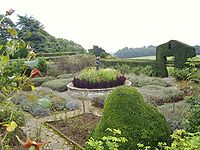
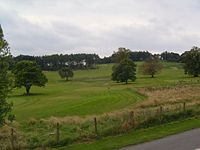
Dundee
Dundee is the fourth-largest city in Scotland and the 39th most populous settlement in the United Kingdom. It lies within the eastern central Lowlands on the north bank of the Firth of Tay, which feeds into the North Sea...
's jute
Jute
Jute is a long, soft, shiny vegetable fibre that can be spun into coarse, strong threads. It is produced from plants in the genus Corchorus, which has been classified in the family Tiliaceae, or more recently in Malvaceae....
industry as mill owners (and had sold cloth for sandbags to both sides during the American Civil War), and Sharp had added venture capital and rail transport to his business interests (he was chairman of the London, Midland and Scottish Railway
London, Midland and Scottish Railway
The London Midland and Scottish Railway was a British railway company. It was formed on 1 January 1923 under the Railways Act of 1921, which required the grouping of over 120 separate railway companies into just four...
). His intention was to construct a new family home with ready access to Dundee
Dundee
Dundee is the fourth-largest city in Scotland and the 39th most populous settlement in the United Kingdom. It lies within the eastern central Lowlands on the north bank of the Firth of Tay, which feeds into the North Sea...
and to his golfing interests at St Andrews
St Andrews
St Andrews is a university town and former royal burgh on the east coast of Fife in Scotland. The town is named after Saint Andrew the Apostle.St Andrews has a population of 16,680, making this the fifth largest settlement in Fife....
' Royal and Ancient Golf Club
The Royal and Ancient Golf Club of St Andrews
The Royal and Ancient Golf Club of St Andrews is one of the oldest and most prestigious golf clubs in the world . It is based in St Andrews, Fife, Scotland, and is regarded as the worldwide "Home of Golf"...
. He also wanted somewhere to house his already extensive collection of paintings, tapestries, furniture and porcelain. Although the location of Wemyss Hall met his requirements, the accommodation did not, and so he engaged the architect Sir Robert Lorimer. Lorimer had recently transformed Kellie Castle
Kellie Castle
Kellie Castle is a castle just outside Arncroach, about 5 kilometres north of Pittenweem in the East Neuk of Fife, Scotland.-Early history:The earliest records of Kellie go back to 1150 where it is mentioned in a charter issued by King David I. The first known owner was Robert of London, the...
, just ten miles (16 km) away. Over the next two years, the new mansion house (named Hill of Tarvit) replaced the main block of the earlier house, although the rear service wings were retained. The new house was fitted with all modern conveniences, including electricity, an internal phone system and central heating. Sharp added a 9-hole golf course in 1924 to the south of the house.
Hugh Sharp (born 1897), Frederick's only son, inherited the house on his father's death in 1932. Hugh, who had served with distinction during the 1914-18 war
World War I
World War I , which was predominantly called the World War or the Great War from its occurrence until 1939, and the First World War or World War I thereafter, was a major war centred in Europe that began on 28 July 1914 and lasted until 11 November 1918...
, added to the house's collection, his particular interests being rare books, and botanical specimens (many of which can still be seen in the gardens). In 1937, Hugh was travelling by rail to meet his fiancée Mabel Hogarth in Glasgow. He was one of 35 people killed when the Glasgow-Edinburgh express collided with a stationary train at Castlecary
Castlecary
Castlecary is a small village on the border between the North Lanarkshire and Falkirk council areas in Scotland. It is close to the new town of Cumbernauld....
. (See Castlecary rail accidents.) His mother Beatrice continued to live at Hill of Tarvit until her death in 1946. Two years later, on the death of his sister Elizabeth, the house and the family's collection was left to the National Trust for Scotland, with a sizable endowment for upkeep. Hugh's book collection was presented to the National Library of Scotland
National Library of Scotland
The National Library of Scotland is the legal deposit library of Scotland and is one of the country's National Collections. It is based in a collection of buildings in Edinburgh city centre. The headquarters is on George IV Bridge, between the Old Town and the university quarter...
.
Until 1977, only the ground floor of the house was open to the public, and then only by appointment, the upper floors being used by the Marie Curie Foundation
Marie Curie Cancer Care
Marie Curie Cancer Care is a charitable organisation in the United Kingdom which provides nursing care, free of charge, to terminally ill people, giving them the chance to choose to be cared for at home...
as a convalescent home.

